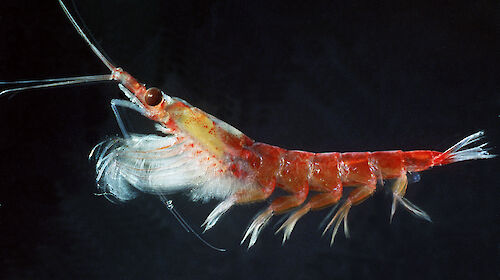Krill, an essential component in the diet of Antarctic penguins, is the major focus of a series of research programs to be conducted from onboard the ice-breaker Aurora Australis, that departs Hobart on New Year’s Day (1 January 2001).
The investigations into krill populations and distribution to be conducted from onboard the Aurora Australis will be carried out in conjunction with research undertaken on Béchervaise Island near Australia’s Mawson station and the site of a ten year study of a small Adélie penguin colony. Ahead of the research voyage, satellite-tracking transmitters will be fitted to the Adélies. These will be used to direct the ship to the precise location where the penguins are feeding. As the research will conducted at the most crucial time for the survival of penguin chicks – when parent birds are busily engaged in collecting food for their land-based chicks – scientists should be able to better relate krill abundance with penguin population survival.
Back onboard the Aurora Australis a comprehensive series of hydro-acoustic and net sampling surveys will collect data on the abundance and variation in the distribution of krill, zooplankton and fish. Of particular interest will be a study of the behaviour of krill swarms as the ship approaches and passes overhead. These data will enable scientists to start the task of devising comprehensive models of prey-predator interactions.
Dr Graham Hosie, leader of the research voyage, says that the work to be carried out will provide information vital to the establishment of a comprehensive management regime for the commercial fishing of krill – a regime that takes into account the needs of the entire ecosystem.
“We need to gather very detailed information on how these species interact. When, how and where the krill aggregate, and at the same time we need to know the success, or otherwise, of the penguins in foraging for this essential component of their diet”, Dr Hosie said today.
Another important research program to be conducted during the Aurora Australis’ 10 week voyage will be the oceanographic component of a study into the history of retreat and advance of the massive Amery ice-shelf, near Australia’s Davis station.
Researchers camped out on the ice-shelf are already well advanced in their program to drill through the north-eastern corner of the ice shelf, which will allow access to sediment samples from the sea floor some 400 metres beneath the ice-shelf. Before the party leaves the ice for this season, instruments to measure ice temperature will be lowered down into the hole.
Aboard the Aurora Australis oceanographers will use ocean measurements of temperature, salinity and velocity to estimate the melt and refreeze rate of the ice-shelf. The combined studies will provide comprehensive data that will contribute to the monitoring of changes in ice-shelves over time as a response to climate change.
Researchers will also deploy sea-floor moorings equipped with a range of instruments, including upward looking sonars (ULS) that will measure ice thickness from beneath the frozen winter sea.
The Aurora Australis is scheduled to depart Macquarie Wharf No 5 at noon on Monday 1 January 2001, and is expected to return to Hobart on 10 March 2001.

